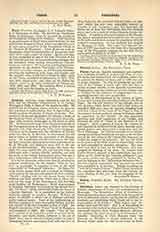

Ferre, VICENTE, theologian, b. at Valencia, Spain; d. at Salamanca in 1682. He entered the Dominican Order at Salamanca, where he pursued his studies in the Dominican College of St. Stephen. After teaching in several houses of study of his order in Spain, he was called from Burgos to Rome, were for eighteen years he was regens primavarius of the Dominican College of St. Thomas ad Minervam. From Rome he went to Salamanca, where he became prior to the convent and, after three years, regent of studies. In his own time he was recognized as one of the best Thomists of the seventeenth century, and posterity acknowledges that his published works possess extraordinary fullness, clearness, and order. He died while publishing his commentaries on the Summa Theologica of St. Thomas. We have two folio volumes on the Secunda Secundae, covering the treatises of faith, hope, and charity, and the opposite vices, published at Rome in 1669; three on the Prima, published in Salamanca, in 1675, 1676, and 1678 respectively; and three on the Prima Secundae, down to Q. cxiii, published at Salamanca, 1679, 1681, and 1690. His confrere Perez a Lerma added to Q. cxiv the treatise on merit.

